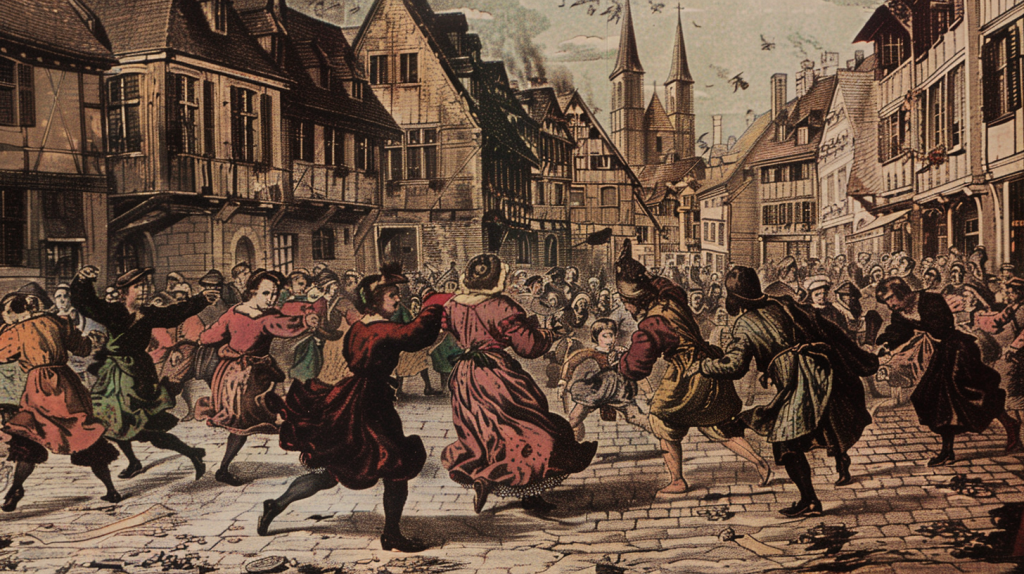In the sweltering summer of 1518, the cobblestone streets of Strasbourg erupted into a frenzy of uncontrollable dancing. It began with a single woman, Frau Troffea, whose feet seemed possessed by an invisible force. Within days, dozens joined her manic jig. By August, nearly 400 people were caught in this bizarre spectacle, dancing day and night until they collapsed from exhaustion or, in some cases, danced themselves to death. This peculiar outbreak, known as the Dancing Plague of 1518, has perplexed historians and scientists for centuries, leaving us to wonder: what could drive hundreds to dance until they dropped?

The Outbreak Begins
According to historical records, the dancing plague began with one ordinary woman, the wife of a shoemaker.
Frau Troffea’s Fateful First Steps
On a humid July day, Frau Troffea stepped out of her modest home near the River Ill. Neighbors later recalled how she paused, as if listening to distant music only she could hear. Then, without warning, she began to dance.
Her husband, a local shoemaker, tried to coax her inside as evening fell. But Frau Troffea kept dancing, her eyes glazed and distant. As the sun rose the next day, she was still moving, her feet bloody and swollen.
“It was as if the devil himself had taken hold of her legs,” one witness would later write in his journal.
The Contagious Choreography
Within a week, 34 others had joined Frau Troffea’s relentless dance. By month’s end, 400 people were swept up in the mania. The streets of Strasbourg became a chaotic ballet, with dancers whirling and leaping until they fell unconscious.
Life in 16th Century Strasbourg
To understand the Dancing Plague, we must first step into the world of 1518 Strasbourg. This was a time of hardship and superstition. The city, while prosperous, was overcrowded and unsanitary. Disease was rampant, and the specter of famine loomed large.
People lived in constant fear. They believed in witches, demons, and divine punishment. When unexplainable events occurred, supernatural causes were often the first explanation.
Attempts to Cure the Dancers
There were medical services in medieval times, although many of the “cures” were ineffective or plain dangerous. However, cures were often a blend of the medical and religious beliefs of the time.
A Musical Solution?
In a decision that seems baffling to modern eyes, Strasbourg’s authorities believed the cure for too much dancing was… more dancing. They constructed wooden stages in public squares and hired musicians to play lively tunes.
At the time, people thought if the afflicted could dance out whatever was possessing them, they’d be cured. Instead, it likely encouraged more people to join in, spreading the mania further.
Medical Explanations of the Time
Local physician Johannes Geiler von Kaysersberg blamed the plague on “overheated blood.” His prescription? More dancing to work the “bad blood” out of their systems.
Others pointed fingers at a variety of culprits:
- Poisonous spiders
- Evil spirits
- A curse from Saint Vitus, patron saint of dancers
Theories About the Cause
Today, with hindsight and more advanced medical and scientific knowledge, the actual cause is still unknown, but we can theorize with some degree of likelihood.
Mass Hysteria
Today, many experts believe the Dancing Plague was a severe case of mass psychogenic illness, formerly known as mass hysteria.
In times of extreme stress, the mind can produce physical symptoms. When others see these symptoms, they can ‘catch’ them, creating a snowball effect.
The Ergot Theory: Toxic Bread?
Another compelling theory involves ergot, a fungus that grows on rye. When consumed, ergot can cause hallucinations, spasms, and a burning sensation in the limbs – symptoms that could be mistaken for frenzied dancing.
Ergot poisoning is a real possibility, according to experts. A contaminated grain supply could have affected a large portion of the population, especially the poor who relied heavily on rye bread.
The End of the Dance
After several grueling months, the dancing finally ceased. The exact death toll remains unknown, but estimates range from 15 to 100 casualties.
Frau Troffea, the woman who started it all, disappeared from historical records. Some speculate she died, while others believe she may have fled the city to escape scrutiny.
Legacy of the Dancing Plague
The Dancing Plague of 1518 wasn’t an isolated incident. Similar outbreaks occurred across Europe between the 14th and 17th centuries:
- In 1374, thousands danced in the streets of Aachen, Germany
- In 1518, just before the Strasbourg incident, a smaller outbreak occurred in Bolsena, Italy
These events, if really due to mass hysteria, reveal how vulnerable we are to mass suggestion. While we may think we’re beyond such things today, modern equivalents exist – from viral social media challenges to financial market panics.
